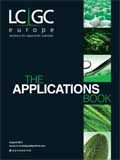Low Level Enantiomeric Impurity Analysis Using the Acquity UPSFC System
Waters Application Note
The high detection sensitivity of the Acquity UPSFC system enables the identification and quantificationof enantiomeric impurities in drug substances.
Goal
To demonstrate the fast chiral separation of benzyl mandelate and the enantiomeric excess determination at 0.02% impurity level using the Waters Acquity UPSFC system.

Figure 1: Chemical structures of R- and S-benzyl mandelate.
Background
According to the September 2005 issue of Chemical & Engineering News, nine out of the top ten drugs (based on sales figures) have chiral active ingredients, and five of those nine drugs have single enantiomeric active ingredients. The single enantimeric form of a chiral drug is considered an improved chemical entity, which may offer a higher efficacy, a better pharmacological profile and a more favourable adverse reaction profile. For the manufacturers of single enantiomeric drugs, the undesired stereoisomers should be considered in the same manner as other organic impurities, Regulatory requirements for the identification, quantification and control of impurities in drug substances and their formulated products have been explicitly defined by the International Conference of Harmonization (ICH). The threshold for identification and quantification of organic impurities is 0.1% for the majority of compounds, according to the ICH.

Figure 2: UPSFC chromatogram of R- and S-benzyl mandelate at 0.20 mg/mL of each enantiomer.
The Solution
Benzyl mandelate, shown in Figure 1, is an important synthetic intermediate for pharmaceutical synthesis. A racemic mixture of R- and S-benzyl mandelate (0.20 mg/mL in methanol for each enantiomer) was separated using the Acquity UPSFC system, and the chromatogram is shown in Figure 2. Key experimental parameters are listed in Table 1.

Figure 3: UPSFC chromatogram of R- and S-benzyl mandelate showing the LOD of the S-benzyl mandelate at 0.02% of the main peak (2 mg/mL).
The overall analysis time was less than 1.5 min. Average base peak widths were less than 6 s. Based on the peak area, the ratio of the R- and S-benzyl mandelate was 0.997. Retention time and peak area repeatability measurements were based on five replicate injections, as summarized in Table 2. At 0.20 mg/mL concentration, repeatability for retention time was better than 0.23% RSD and better than 0.5% RSD for peak area.

Table 1: Key experimental parameters.
Figure 3 shows the UPSFC chromatogram of R-benzyl mandelate at 2 mg/mL. The minor peak at 1.30 min corresponds to S-benzyl mandelate as confirmed by the UV spectrum (results not shown). This S-benzyl mandelate impurity peak has an S/N of ~3 (LOD) and represents 0.02% of the major peak based on the peak area. This increased detection sensitivity can be attributed to the holistically designed Acquity UPSFC system, which includes an improved detector design. The enantiomeric excess (e.e.) in this case was 99.96%.

Table 2: Retention time and peak area repeatability at 0.20 mg/mL of each enantiomer.
Summary
UPSFC chiral separation of R- and S-benzyl mandelate in less than 1.5 min were successfully demonstrated using the Acquity UPSFC system. At 0.20 mg/mL concentration of each enantiomer, excellent repeatability (better than 0.23% RSD for retention time and better than 0.5% RSD for peak area) was obtained. Improved detection sensitivity, resulting from a new pumping system and optimized detector design, made detection of a 0.02% enantimeric impurity and e.e. determination possible. The Acquity UPSFC system is suitable for the analysis of low level enantiomeric impurities, enantiometic excess determinations and QA/QC analyses.
Waters is a registered trademark of Waters Corporation. The Science of What's Possible, Acquity UPSFC and UPSFC are trademarks of Waters Corporation.

Waters Corporation
34 Maple Street, Milford, Massachusetts 01757, USA
tel: +1 508 478 2000 fax: +1 508 872 1990
Website: www.waters.com

Separating Impurities from Oligonucleotides Using Supercritical Fluid Chromatography
February 21st 2025Supercritical fluid chromatography (SFC) has been optimized for the analysis of 5-, 10-, 15-, and 18-mer oligonucleotides (ONs) and evaluated for its effectiveness in separating impurities from ONs.

.png&w=3840&q=75)

.png&w=3840&q=75)



.png&w=3840&q=75)



.png&w=3840&q=75)

















